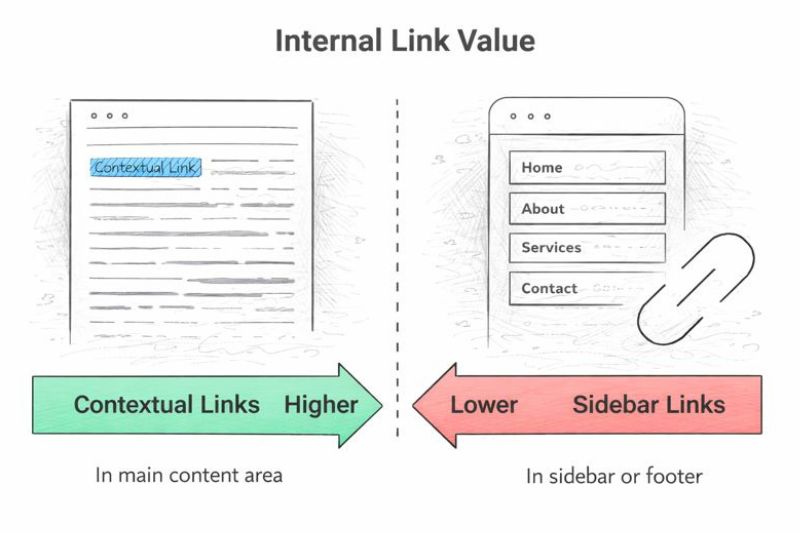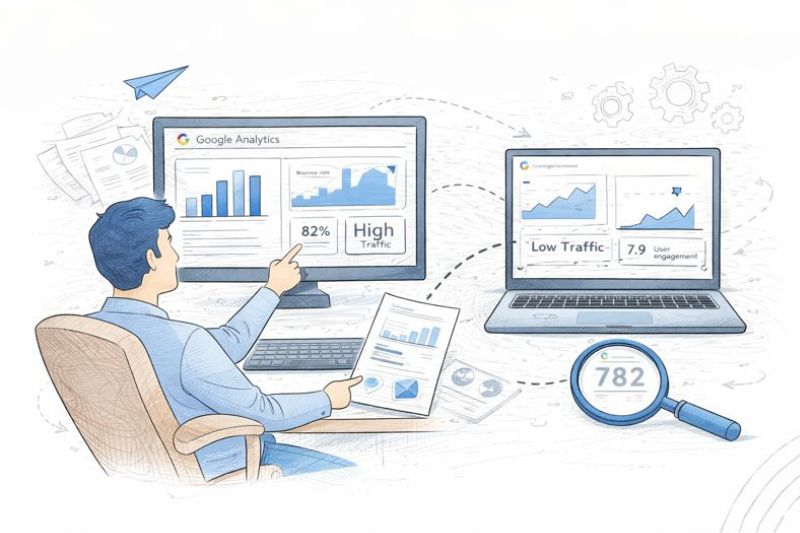Let’s start with a confession: we used to think internal linking was the boring cousin of “real” SEO work.
You know, the stuff that actually mattered. External links, technical optimizations, content creation. Internal linking felt like housekeeping. Something you’d get to eventually, maybe, if you had time left over.
We were dead wrong.
After building thousands of links for clients across every industry imaginable, we’ve seen sites stuck on page 2 for months suddenly jump to position 3 just by fixing their internal linking structure. We’ve watched perfectly optimized pages with solid backlinks languish in obscurity because they weren’t connected to the rest of the site properly.
The truth is, most websites are bleeding potential rankings because they treat internal linking like an afterthought. And most SEO advice about internal linking is either completely generic or flat-out wrong.
Why 90% of Internal Linking Advice Is Useless
Walk into any SEO conference and you’ll hear the same tired advice about internal linking:
“Use descriptive anchor text!” (No kidding, Sherlock) “Link to relevant pages!” (Revolutionary thinking there) “Don’t use too many links!” (What’s too many? Nobody ever says)
Here’s what nobody talks about: most internal linking strategies fail because they’re built backwards.
Everyone starts by asking “How do we add internal links?” The right question is “How do we distribute link equity to the important pages that actually matter for your business?”
The Authority Distribution Problem
Here’s something we learned from analyzing client sites: the most authoritative pages getting the most internal links are rarely the pages that drive revenue.
Your blog gets linked to constantly. Your about page gets navigational links from every page on your site. Your random category pages accumulate incoming internal links over time.
But your high converting landing pages? Your money pages? They’re sitting there with maybe 2-3 internal links pointing to them total.
We had a client in the accounting space whose homepage was getting 47 internal links, but their “CPA Services” page (their main revenue driver) had exactly 3. Three! After redistributing link authority to focus on their important pages, their organic leads increased by 34% in two months.
What Google Actually Cares About
Let us share something most people don’t realize about how search engines process internal links.
Google doesn’t just count your internal links and divide page authority equally. Search engine crawlers look at:
Link position on the web page – Contextual links in your main content area carry way more link value than sidebar links or footer links. We’ve tested this extensively.
Source page authority – A link from your homepage isn’t equal to a link from a random blog post. Not even close.
Link context – Search engines understand semantic relationships between linked pages. Random links between unrelated topics actually hurt more than they help.
User behavior signals – If people consistently click certain internal links and spend time on the linked page, those links get weighted higher.
The last point is huge. Internal links aren’t just about passing link authority, they’re about user experience. And search engines track user behavior.

The Hub Page Strategy That Actually Works
Everyone talks about topic clusters and hub pages. Most implement them wrong.
The mistake: creating artificial hub pages that exist purely for SEO. Search engines see right through this.
The solution: identify your existing high-traffic pages that already discuss broad topics, then strategically add internal links from those pages to more specific relevant content.
We had an e-commerce client whose product category pages were getting solid traffic but terrible conversion rates. Instead of creating new “hub pages,” we optimized their existing category pages to link strategically to specific product pages based on search intent.
Result? 28% increase in organic conversions within 60 days.
The Anchor Text Myths Nobody Talks About
“Use descriptive anchor text” is only half the story. Here’s what really matters:
Variation beats perfection – We analyzed 50+ successful campaigns. Sites with the most ranking improvements used 60-70% exact match descriptive anchor text, 20-25% partial match, and 10-15% branded/generic. Not 100% “optimized” anchors like everyone preaches.
Context trumps keywords – An anchor like “SEO consultant” works better when it’s surrounded by relevant content than when it’s randomly dropped into unrelated text.
Position matters more than you think – Anchor text in the first 100 words of content carries significantly more link value than links buried at the bottom of long articles.
The “Too Many Links” Myth
How many internal links should a page have? Every blog post says “2-5 per 1000 words” like it’s gospel.
We’ve seen pages with many internal links (15+ contextual ones) that rank beautifully, and pages on your site with 2 “perfectly optimized” links that can’t break the top 50.
The real rule: every link should serve a purpose. If someone reading your content would genuinely benefit from clicking that link, include it. If you’re adding links just to hit some arbitrary number of internal links, you’re doing it wrong.
One of our highest-performing clients has an average of 8 internal links per blog post. Their pages consistently outrank competitors with fewer, “better optimized” links.
The Technical Stuff Most People Ignore
Here’s where things get interesting. Most internal linking advice focuses on the obvious stuff. The real gains come from the technical details nobody talks about.
Crawl budget optimization – If you have a large site, search engine bots only crawl a limited number of your individual pages per day. A solid internal linking strategy helps direct that crawl budget to your important pages.
Link authority flow – Not all internal links pass the same amount of link value. Links from pages with more external links pointing to them pass more authority to linked pages.
JavaScript link discovery – If your internal links are generated by JavaScript that loads after the initial page render, search engines might not follow them. We’ve seen massive ranking improvements just by moving critical internal links into the initial HTML.
What Doesn’t Work (But Everyone Still Does)
Keyword stuffing in anchors – Using your exact target keyword as anchor text for every internal link pointing to a page. This looks spammy and can actually hurt rankings.
Random related post widgets – Those “you might also like” sections with computer-generated suggestions. They add link clutter without strategic value.
Footer link spam – Cramming dozens of links into your footer hoping to boost page authority. Google largely ignores footer links now.
Over-linking to your homepage – Your homepage doesn’t need 47 internal links. It really doesn’t.
The Real Internal Linking Best Practices
Here’s what actually moves the needle:
Focus on Money Pages First
Identify the 5-10 pages that directly drive revenue for your business. These should receive the majority of your internal link building efforts. Everything else is secondary.

Create Semantic Link Clusters
Don’t just link between related topics. Create tight clusters of content around specific themes, with clear hierarchies pointing toward your most important pages.
Use Data to Guide Decisions
Look at your Google Analytics. Which pages have high traffic but high bounce rates? Those pages need better internal linking to guide users deeper into your site.
Which pages have great engagement but low traffic? Those need more internal links pointing to them from high-traffic pages.
Test and Measure
This is the big one nobody talks about. Internal linking isn’t set-it-and-forget-it. Test different approaches and measure the results.
We use tools like Hotjar to see which internal links people actually click, then double down on the patterns that work.
The Advanced Strategies
Once you’ve got the basics down, there are some advanced internal linking strategies that can really move the needle:
Authority stacking – Systematically linking from your highest-authority pages down to target pages in a hierarchical structure.
Contextual link insertion – Going back to older content and adding strategic internal links when they genuinely add value to the reader.
Seasonal link optimization – Adjusting internal link priority based on seasonal search trends and business cycles.
Want to see how this actually works in practice? We’ve helped businesses across industries build link strategies that drive real results. Contact us and we’ll show you exactly how we’d approach your site’s internal linking.
The Mistakes That Kill Results
Linking for the sake of linking – Adding internal links because some blog post said you should, not because they add value.
Ignoring user intent – Linking between pages that have no logical connection from a user perspective.
Setting it and forgetting it – Internal linking isn’t a one-time task. It’s an ongoing process that should evolve as your site grows.
Following generic advice – Every site is different. What works for a massive e-commerce site won’t work for a local service business.
Tools That Actually Help
Most internal linking tools are garbage. They analyze your current links and suggest more of the same, which isn’t useful if your current strategy sucks.
Here are the tools we actually use:
Screaming Frog – For technical internal link audits and finding broken internal links
Ahrefs Site Audit – Shows internal link distribution and identifies orphaned pages on your site
Google Analytics – User behavior data to see which internal links people actually use
Hotjar – Heat maps showing which internal links get clicked
The key is using tools to inform strategy, not replace it.
Internal Linking for Different Site Types
What works varies dramatically based on your site type:
E-commerce sites – Focus on guiding users from category pages to specific products. Cross-sell and upsell through strategic internal linking.
Service businesses – Connect blog content to service pages. Create clear pathways from information to conversion.
Content sites – Build topic authority through interconnected content clusters. Keep users engaged with relevant related content.
SaaS companies – Link from feature-focused content to specific landing pages. Guide users through the awareness-to-consideration journey.
The Mobile Reality Check
Here’s something most people ignore: mobile users behave differently with internal links.
Desktop users might click 3-4 internal links per session. Mobile users average 1-2.
This means your mobile internal linking strategy should be more focused and intentional. The links you include need to be the most valuable ones, not just convenient filler.
Looking at the Competition
One of our favorite competitive research tactics: analyze how successful competitors structure their internal and external links.
Not to copy them, but to understand their strategy. Which important pages do they prioritize? How do they connect topics? What patterns can we improve on?
We use tools like Ahrefs to export competitor link structures, then look for gaps and opportunities.
The Content Connection
Internal linking works best when it’s planned from the content creation stage, not bolted on afterward.
When we create content for clients, we ask:
How does this piece connect to existing content?
What internal link opportunities does this create?
Which existing pages should link to this new content?
This approach creates naturally interconnected content that doesn’t feel forced or manipulative.
Measuring What Matters
Forget vanity metrics. Here’s what we actually track for internal linking success:
Organic traffic to target pages – Are your priority pages getting more visibility?
User engagement signals – Time on site, pages per session, bounce rate improvements
Conversion path analysis – How do internal links contribute to conversions?
Crawl efficiency – Are search engines discovering and indexing your important pages faster?
We’ve found that sites with optimized internal linking structure show improvements in all these areas within 30-60 days.
Check out our SEO case studies to see specific examples of how internal linking improvements translated into real business results.
The Bottom Line
Internal linking isn’t sexy. It’s not the kind of thing you brag about at marketing conferences. But it’s one of the most powerful tools in your SEO arsenal because it’s completely under your control.
You can’t control when (or if) other sites link to you. You can’t control Google’s algorithm updates. But you can control how authority flows through your own site.
Most businesses are sitting on massive internal linking opportunities right now. Pages that could rank higher with better internal support. Content that could drive more conversions with strategic link placement.
The question isn’t whether internal linking works. It’s whether you’re going to implement it properly or keep following generic advice that doesn’t move the needle.
What are internal links in SEO, and why are internal links important?
Internal links are hyperlinks that connect one page on the same website to other pages. Internal links are important because they help search engines understand site structure, pass link equity, and direct users to relevant content.
How many internal links should a page have?
There’s no fixed number of internal links per page. A good practice is to add internal links where they benefit users and search engines, avoiding too many internal links that dilute link value.
What’s the difference between internal and external links?
Internal links point to other pages on your site (same domain), while external links point to other websites. Both links are important for SEO, but internal links play a bigger role in site architecture and authority distribution.
Why is a solid internal linking strategy important?
An effective internal linking strategy ensures that important pages receive more internal links from high authority pages. This helps distribute link equity, improve page authority, and boost search engine rankings.
What are contextual links vs navigational links?
Contextual links appear in the main body of a web page, pointing to related pages and helping search engines understand relevance. Navigational links, such as sidebar links or menu links, improve site structure but carry less link authority.
What is an internal link audit?
An internal link audit checks your website’s internal linking structure for broken links, orphaned pages, and opportunities to add internal links pointing to important pages. It helps optimize link authority flow and improve SEO.
How do search engines use internal links?
Search engine crawlers follow internal links to find pages, understand site architecture, and decide which pages are most authoritative. Without incoming internal links, new pages may never be discovered or ranked.

